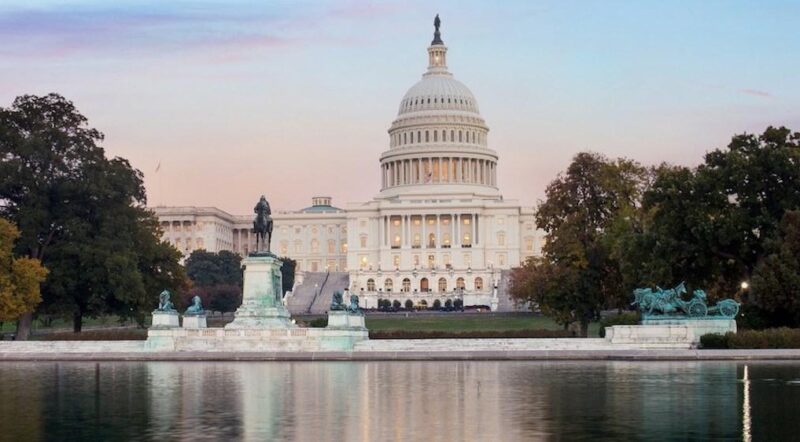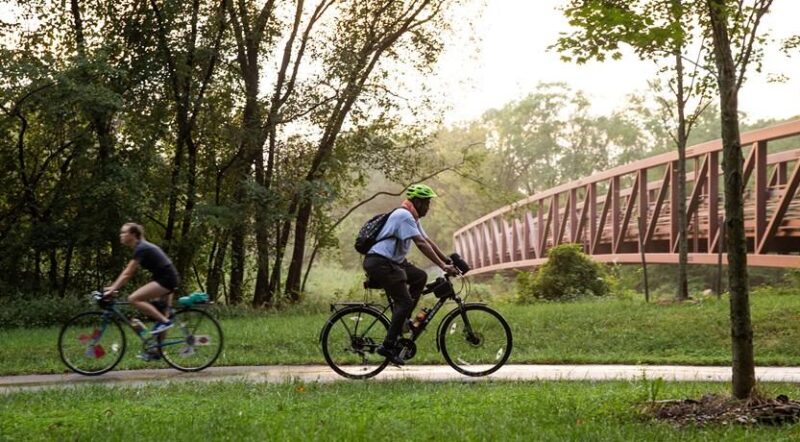BUILD FAQ
Photo courtesy Getty Images
Better Utilizing Investments to Leverage Development (BUILD) Frequently Asked Questions
The Better Utilizing Investments to Leverage Development (BUILD) program (formerly RAISE) is a competitive, merit-based grant program open to all surface transportation projects that advance national priorities. Since this grant program is open to all surface transportation types, it is highly competitive.
Rails-to-Trails Conservancy (RTC) wants to make sure you have all the information you need as you consider whether this funding program is right for your trail and active transportation project. After you have looked over the NOFO, we encourage you to browse our answers to your frequently asked questions about how this grant can be used for your projects.
If you do decide to apply for a BUILD (formerly RAISE) grant, either in this round or in the future, please read the entirety of the USDOT’s NOFO and register for, or watch recordings from, the USDOT’s webinar series for application assistance.
To find all FAQs, you can visit USDOT’s website.
If you are thinking of applying for a BUILD grant, or have already applied, we would love to hear about it! Please contact us with any information or additional BUILD-related questions for your trail and active transportation projects. For specific application questions, please visit the USDOT’s BUILD page or email them at BUILDgrants@dot.gov.
What are BUILD grants?
The Better Utilizing Investments to Leverage Development (BUILD) Grants are a continuation of the U.S. Department of Transportation’s (USDOT’s) multimodal and multijurisdictional competitive grant program formerly known as both TIGER and RAISE.
What changed in the amended NOFO?
The amended NOFO:
- Changes the program name from RAISE to Better Utilizing Investments to Leverage Development (BUILD)
- Removes references to rescinded Executive Orders
- Aligns the NOFO with new Executive Orders
- Specifies $150 million is available for award
- Defines Historically Disadvantaged Communities using the same statutory definition for Areas of Persistent Poverty
- Clarifies all grant agreements or contracts must include terms that are in compliance with Section 3(C)(iv) of EO Ending Illegal Discrimination and Restoring Merit-Based Opportunity
Who can receive BUILD Grants?
Eligible Applicants for BUILD grants are:
- States and the District of Columbia;
- any territory or possession of the United States;
- a unit of local government;
- a public agency or publicly chartered authority established by 1 or more States;
- a special purpose district or public authority with a transportation function, including a port authority;
- a Federally recognized Indian Tribe or a consortium of such Indian Tribes;
- a transit agency; and
- a multi-State or multijurisdictional group of entities that are separately eligible.
- In addition to projects located in the United States, eligible projects for BUILD grants include projects that are necessary for reconstruction of the Alaska Highway from the Alaskan border at Beaver Creek, Yukon Territory, to Haines Junction in Canada and the Haines Cutoff Highway from Haines Junction in Canada to Haines, Alaska, as provided in 23 U.S.C. 218.
- Multiple States or jurisdictions may submit a joint application and must identify a lead applicant as the primary point of contact and identify the primary recipient of the award. Joint applications must include a description of the roles and responsibilities of each applicant.
Tribal Governments are eligible applicants. Projects on facilities that are owned by an eligible applicant but located on Federally owned land for which the title or maintenance responsibility is vested in the Federal Government, such as Bureau of Indian Affairs-owned roads, are eligible.
What types of projects are eligible for BUILD Grants?
Eligible projects for BUILD grants are:
Capital projects including but not limited to:
- highway, bridge, or other road projects eligible under title 23, United States Code;
- public transportation projects eligible under chapter 53 of title 49, United States Code;
- passenger and freight rail transportation projects;
- port infrastructure investments (including inland port infrastructure and land ports of entry);
- the surface transportation components of an airport project eligible for assistance under part B of subtitle VII
- intermodal projects;
- projects to replace or rehabilitate a culvert or prevent stormwater runoff for the purpose of improving habitat for aquatic species while advancing the goals of the BUILD program;
- projects investing in surface transportation facilities that are located on Tribal land and for which title or maintenance responsibility is vested in the Federal Government; and
- any other surface transportation infrastructure project that the Secretary considers to be necessary to advance the goals of the program.
Planning projects which include planning, preparation, or design (for example – environmental analysis, equity analysis, community engagement, feasibility studies, benefit cost analysis (BCA), and other pre-construction activities) of eligible surface transportation capital projects that will not result in construction with FY 2025 BUILD funding.
What merit criteria will be used to evaluate my application?
The merit criteria review will be based on the following:
- Safety
- Environmental sustainability
- Quality of life
- Mobility and community connectivity
- Economic competitiveness
- State of good repair
- Partnerships and collaboration
- Innovation
What are the minimum and maximum grant award sizes?
For capital projects located in urban areas, the minimum award is $5 million. Please note that the minimum total project cost for a project located in an urban area (and is not APP or HDC) must be $6.25 million to meet match requirements.
For capital projects located in rural areas, the minimum award is $1 million.
Planning projects do NOT have a minimum award size.
The maximum grant award is $25 million.
Am I required to submit a Benefit-Cost Analysis (BCA)?
You are required to complete a Benefit-Cost Analysis (BCA) for capital projects; however, planning grant applications do not require a BCA.
Please review the most current BCA guidance published by DOT’s Chief economist, as well as the Benefit-Cost Analysis Spreadsheet Template for Discretionary Grant Programs.
The Department also offers BCA webinars.
If an application includes multiple project components with independent utility, is a BCA needed for each component or only for the entire project?
While USDOT allows for packages of projects to be included in a single grant application, each component of such package with independent utility should be evaluated separately, with its own BCA. The costs and benefits of each individual component may also be aggregated to provide a summary estimate of net benefits for the entire package. Where projects within a package may be expected to also have collective benefits that are larger than the sum of the benefits of the individual project components, applicants should clearly explain why this would be the case and provide any supporting analyses to that effect. DOT recognizes the technical challenges in preparing a BCA and encourages applicants to do their best in demonstrating the anticipated benefits and estimated costs of the entire project as well as appropriate components.
What are the definitions for urban and rural under BUILD?
A project is designated as “urban” if it is located in a 2020 Census-designated Urban Area (UA) and that UA had a population greater than 200,000.
A project will be designated as “rural” if it is located:
- In an UA that had a population less than 200,000 in the 2020 Census, or
- Outside an UA.
For example, a project located in an UA with a population of 150,000 will be designated as rural under the FY 2025 BUILD program. In contrast, a project located in an UA with a population of 250,000 will be designated as urban, even if the city or town in which the project is located has a population of 100,000.
For projects that include expenditures in both urban and rural areas, the Department will designate the project as urban or rural based on where the majority of project funds will be spent.
How do applicants determine if the project is urban or rural?
To determine if a location is in a Census-designated Urban Area (UA) with a population greater than 200,000 in the 2020 Census, please see the:
- BUILD Grant Project Location Verification mapping tool.
How much will the Department award to rural and urban projects?
Not more than 50 percent of the $1.5 billion ($750 million) will be spent on projects located in urban and rural areas, respectively.
How do applicants determine if the project is located in an Area of Persistent Poverty and a Historically Disadvantaged Community?
A project is located in an Areas of Persistent Poverty and a Historically Disadvantaged Community if:
- the county (or equivalent jurisdiction) in which the project is located consistently had greater than or equal to 20 percent of the population living in poverty in all three of the following datasets: (a) the 1990 decennial census; (b) the 2000 decennial census; and (c) the 2022 Small Area Income Poverty Estimates, or
- the census tract in which the project is located has a poverty rate of at least 20 percent as measured by the 2014-2018 5-year data series available from the American Community Survey of the Bureau of the Census; or
- the project is located in any territory or possession of the United States.
The BUILD Grant Project Location Verification mapping tool should be used to determine if your project is located in an Area of Persistent Poverty or a Historically Disadvantaged Community.
If a project is in multiple counties or census tracts, but not all counties or census tracts are designated as an Area of Persistent Poverty and a Historically Disadvantaged Community, does it qualify as a project in those areas?
A project located in multiple counties or census tracts will be designated as an Area of Persistent Poverty or within a Historically Disadvantaged Community if the majority of the project’s costs will be spent in county(ies) or census tract(s) that meet the definition of Areas of Persistent Poverty and Historically Disadvantaged Community.
BUILD grants may not be the right funding program for my project, or I have been rejected to receive a BUILD grant, but I want to explore other federal funding opportunities. Where can I find more information about available opportunities?
While BUILD is a great opportunity to secure big investments for your trail and active transportation projects, it is important to remember that the grants are highly competitive, and there is a maximum amount of funds that can be received in each state. We encourage you to save your application materials and incorporate feedback from the USDOT to try for subsequent rounds of this grant program. You may end up receiving one in the future, or you can use your materials for other funding opportunities.
You can visit our Public Funding for Trails and Active Transportation page to find other funding opportunities available for your project, such as the Recreational Trails Program, which is administered at the state level, and the Transportation Alternatives program, which is administered at both the state and MPO levels. You will also find information about a new discretionary funding program authorized by the BIL and specifically meant for projects that connect active transportation networks: the Active Transportation Infrastructure Investment Program. RTC is working with advocates to secure full funding of the program at $500 million in the FY 2023 appropriations process and beyond. Stay tuned for more information about this program and upcoming advocacy opportunities.
BUILD Stories
View More Blogs
Kansas’ Flint Hills Trail State Park Recognized as Hall of Fame Trail

What the 2024 Election Means for Active Transportation
